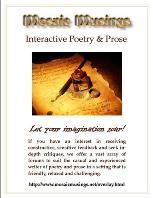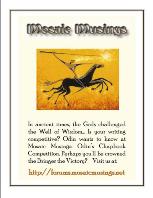 Feb 5 05, 17:47 Feb 5 05, 17:47
Post
#1
|
|
|
Group: Administrator Posts: 18,892 Joined: 1-August 03 From: Massachusetts Member No.: 2 Real Name: Lori Kanter Writer of: Poetry & Prose Referred By:Imhotep |
Hi all.
We've started a discussion regarding the term 'microstory' and a challenge was put forth to create them. I thought I would start a tile here (please 'add reply') so we can practice and comment. I hadn't heard of this term before so I googled it and here are some responses: "A term - as far as I know - first used by MIT during the creation of the never-ending-conversation. A microstory is the smallest particle of a work of interactive fiction. During the creation of a work of interactive fiction, story parts are connected to each other with links or commands (or possibly an at-random sequence). Every story part is a possible followup to another story part. These story parts are called "microstories." ~ from IfWiki.Org "On a grid each point is connected to at least four other points and that contain microstories. Imagine that the point you are on right now tells you about the cat Irma used to have and how she took the animal to bed with her ever since she was a little girl, and how the neighbor killed the cat because it ruined his flowerbeds. Let’s call the microstory you are on right now number 0, and the four grid points this story is connected to are numbered 1 to 4. In my story, grid point number 1 could contain a story about the first time Irma met the cat, number two could be a description of Irma’s bedroom and some other things that happened there, number three could be about the neighbor and his flowerbeds, and number four could be the a description of what Irma did to the neighbor when she found out he killed her cat. And so on. In this way one can design a grid and move from one side to the other and experience a landscape of emotions, stories, events and descriptions that are all thematically linked to one another. But: as in every other story, one has to take care of one tiny detail: does the reader have enough information to understand the next part of the story? In the case of a grid-based story, this is the same, but more complicated because anyone can arrive at any point from several directions. In theory these could be four (or eight when diagonal movements are allowed) but one could limit them to two if the reader can go top-down, right-left. Okay, lets start making things even more complicated. Suppose the story we are telling the audience is based on a map of Irma’s bedroom. Every square contains an item that is connected to a story and all the items are thematically connected on a grid. Irma lived in that room from the time she was a little girl until the day she died. We are presenting this as a point and click story, that is: we walk through the room using different shots of that room and we can move from one shot to another by clicking in the desired direction. Every shot contains an item (or items) and every item tells us a microstory. Microstory number one, the microstory we start with – probably the door to the room - is very important. This is the entrance point to the story and we have to tell the reader everything he or she needs to know about Irma in order to understand what is going on in the next microstories. That is what I call an information point. There could be more information points than one inside Irma’s bedroom. Suppose the story – and therefore the bedroom – starts at the point where Irma is still a little girl of five years old. Several things happened in those days. Especially her father was very important to her then. And when he died everything changed. Her live changed, her mother changed. And of course: the story will change with it. The microstory that contains the story of her father’s death could be another information point. And it could lead us to another room, the room her father lived in. Or it could lead to the same room ten years later. This room also has a grid, maybe the same stuff is on it, maybe not, but Irma has grown older, and the stories that are connected to the items are different. Instead of one square with a grid on it, we are now confronted with two squares connected at one point: the point where we learn that Irma’s father died. We could position those squares on top of each other, creating a cube filled with dots. We can move on through her room, in a different time, and learn everything there is to know about Irma at the age of fifteen. Until we encounter a new information point......." ~from BigBother "As the tool, microstory is used — text unit of a paragraph, summing up the context, form, and content of particular work, event, or theory." "A MicroStory must be 499 words or less." Anyway...anyone care to join in? Here in this exercise, let's limit the word count to 100 or less (per James and Perry)... ·······  ······· ·······"It's a dangerous business, Frodo, going out your door. You step into the Road, and if you don't keep your feet, there is no knowing where you might be swept off to." ~ J.R.R Tolkien, The Lord of the Rings
Collaboration feeds innovation. In the spirit of workshopping, please revisit those threads you've critiqued to see if the author has incorporated your ideas, or requests further feedback from you. In addition, reciprocate with those who've responded to you in kind. "I believe it is the act of remembrance, long after our bones have turned to dust, to be the true essence of an afterlife." ~ Lorraine M. Kanter Nominate a poem for the InterBoard Poetry Competition by taking into careful consideration those poems you feel would best represent Mosaic Musings. For details, click into the IBPC nomination forum. Did that poem just captivate you? Nominate it for the Faery award today! If perfection of form allured your muse, propose the Crown Jewels award. For more information, click here!  "Worry looks around, Sorry looks back, Faith looks up." ~ Early detection can save your life. "Worry looks around, Sorry looks back, Faith looks up." ~ Early detection can save your life.MM Award Winner  |
|
|
|
Posts in this topic
 Cleo_Serapis The Microstory Feb 5 05, 17:47
Cleo_Serapis The Microstory Feb 5 05, 17:47 
 Jox Hi Lori, excellent thread, thanks.
As many will r... Feb 5 05, 17:57
Jox Hi Lori, excellent thread, thanks.
As many will r... Feb 5 05, 17:57 
 Cleo_Serapis OK.
I'll start with something I posted in short s... Feb 5 05, 17:58
Cleo_Serapis OK.
I'll start with something I posted in short s... Feb 5 05, 17:58 
 Cleo_Serapis Thanks James!
I had a hard time just looking the ... Feb 5 05, 18:00
Cleo_Serapis Thanks James!
I had a hard time just looking the ... Feb 5 05, 18:00 
 Jox Hi, here are those two microstories. Both competit... Feb 5 05, 18:12
Jox Hi, here are those two microstories. Both competit... Feb 5 05, 18:12 
 Toumai Ah, I've just done I micro story - posted in S... Feb 6 05, 03:48
Toumai Ah, I've just done I micro story - posted in S... Feb 6 05, 03:48 
 Jox Of Course, Fran and I've critted.
Why don... Feb 6 05, 06:10
Jox Of Course, Fran and I've critted.
Why don... Feb 6 05, 06:10 1 User(s) are reading this topic (1 Guests and 0 Anonymous Users)
0 Members:
  |

|
Lo-Fi Version | Time is now: 8th December 2025 - 00:59 |

















